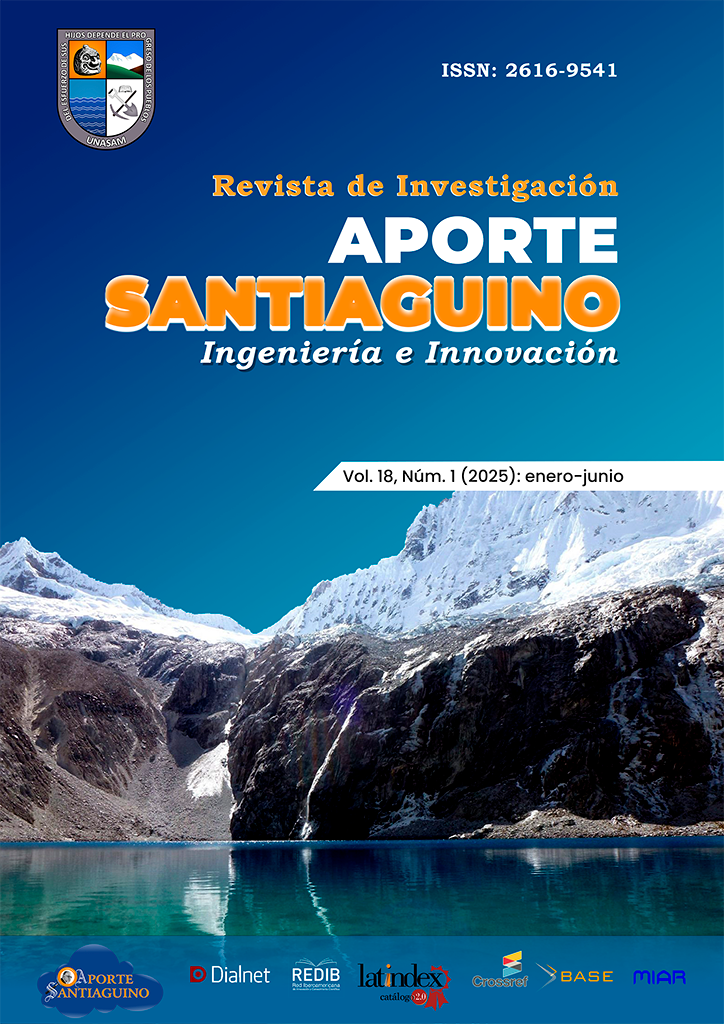Determinación del ángulo óptimo de inclinación para mejorar la captación solar en instalaciones térmicas y fotovoltaicas en zonas cercanas a latitud 0°
DOI:
https://doi.org/10.32911/as.2025.v18.n1.1235Palabras clave:
Insolación, Inclinación, Corrección, IrradiaciónResumen
El objetivo fue determinar los ángulos óptimos de inclinación en la ciudad de Sangolquí-Ecuador que se encuentra a una latitud -0,3º y longitud de -78,44º. En zonas cercanas a la línea ecuatorial, existen serias dificultades para la ubicación e inclinación de las instalaciones térmicas y fotovoltaicas debido a la presencia de nubosidad, lluvias intensas, microclimas variables y cambio en la posición angular diaria del sol que forman trayectorias aparentes, las mismas que tomando en cuenta el medio día solar y la vertical de la localidad, forman ángulos de cénit que cambian desde +23,45 ° el 21 de junio hasta -23,45 ° el 22 de diciembre de cada año. Estos factores disminuyen de manera significativa la capacidad de captación de la luz solar y por consecuencia el rendimiento de instalaciones fijas que utilizan la energía solar para su funcionamiento. Además, el desconocimiento de estas condiciones climáticas y de radiación solar, pueden afectar de manera significativa al dimensionamiento óptimo de captadores planos o paneles fotovoltaicos con la consecuente baja productividad energética y mínima relación beneficio costo.
Descargas
Citas
Allen, R. G., Trezza, R., & Tasumi, M. (2006). Analytical integrated functions for daily solar radiation on slopes. Agricultural and Forest Meteorology. https://doi.org/10.1016/j.agrformet.2006.05012
Arribas, L., Bragado, J., & Caamaño, E. (1999). Energía solar fotovoltaica y cooperación al desarrollo. IEPALA.
Bakirci, K. (2012). General models for optimum tilt angles of solar panels: Turkey case study. Renewable and Sustainable Energy Reviews, 16, 6149–6159. https://doi.org/10.1016/j.rser.2012.07.009
Carg, H. P., & Carg, S. N. (1993). Measurement of solar radiation - I. Radiation instruments. Renewable Energy, 3(4–5), 321–333. https://doi.org/10.1016/0960-1481(93)9099-3
Duffie, J. A., & Beckman, W. A. (2006). Solar engineering of thermal processes (3rd ed.). John Wiley & Sons.
Ekadewi, A., Handoyo, B., & Djatmiko, I. (2012). The optimal tilt angle of a solar collector. International Conference on Sustainable Energy Engineering and Application (ICSAA 2012).
Escalona, M. I., Solís, L. O., Castañeda, C. L., Olvera, C. A., & Martínez, M. R. (2024). Comparative analysis of solar radiation forecasting techniques in Zacatecas, México. Applied Sciences, 14, 7449. https://doi.org/10.3390/app14177449
Goswami, D. Y. (2023). Principles of solar engineering. Taylor and Francis.
Hay, J. E. (1993). Calculating solar radiation for inclined surfaces: Practical approaches. Renewable Energy, 3(45), 372–380.
Heywood, H. (1971). Operating experience with solar heating. JIHVE, 39, 61-69.
Jutglar, L. (2004). Energía solar: Energías alternativas y medio ambiente. Ediciones Ceac.
Keshavarz, S. A., Talebizadeh, P., Adalatia, S., & Mehrabian, M. A. (2022). Optimal slope angles to determine maximum solar energy gain for solar collectors used in Iran. International Journal of Renewable Energy Research, 2.
Khatib, A. T., Samiji, M. E., & Mlyuka, N. R. (2024). Optimum solar collector’s north-south tilt angles for Dar es Salaam and their influence on energy collection. Cleaner Engineering and Technology, 21, 100778. https://doi.org/10.1016/j.clet.2024.100778
Khosravi, A., Sandoval, O. R., Talebjedi, B., Laukkanen, T., García, J. J., & El Haj Assad, M. (2020). New correlations for determination of optimum slope angle of solar collectors. Energy Engineering. https://doi.org/10.32604/EE.2020.011024
Lunde, P. J. (1980). Solar thermal engineering, space heating and hot water systems. John Wiley & Sons.
Mousavi, S. A., Hizam, H., & Gomes, C. (2017). Estimation of hourly, daily and monthly global solar radiation on inclined surfaces: Model revisited. Energies, 10(1), 134. https://doi.org/10.3390/en10010134
Muzathik, A. M., Ibrahim, M. Z., Samo, K. B., & Wan Nik, W. B. (2010). Estimation of solar global irradiation on horizontal and inclined surfaces based on the horizontal measurements. Energy. https://doi.org/10.1016/j.energy.2010.12.003
Myers, D. R. (2003, September 15–16). Solar radiation modeling and measurements for renewable energy applications: Data and model quality. National Renewable Energy Laboratory, Edinburg, Scotland.
Nijegorodov, N., Devan, K. R. S., Jain, P. K., & Carlsson, S. (1994). Atmospheric transmittance models and an analytical method to predict the optimum slope of an absorber plate variously oriented at any latitude. Renewable Energy, 4(5), 529–543.
Norris, D. J. (1996). Solar radiation on inclined surfaces. Solar Energy, 10(2), 72–76.
Oliveira, M., López, H. S., Mendonga, P., & Tenpierik, M. (2024). Solar radiation measurements – Techniques and instrumentation. Buildings, 14(7). https://doi.org/10.3390/buildings14072117
Qiu, G., & Riffat, S. B. (2003). Optimum tilt angle of solar collectors and its impact on performance. International Journal of Ambient Energy, 24(1), 13–20. https://doi.org/10.1080/01430750.2003.9674898
Rufes Martines, P. (2010). Energía solar térmica: Técnicas para su aprovechamiento (1ra ed.). Editorial Marcombo.
Tangkemanda, A., & Susanto, A. (s.f.). The effect of collector slope angle on the performance of solar water heater. Sulawesi Selatan.
Yang, D. (s.f). Solar radiation on inclined surfaces: Corrections and benchmarks. Solar Energy, 136, 288–302. https://doi.org/10.1026/j.solener.2026.06.062
Younes, S., Claywell, R., & Muneer, T. (2005). Quality control of solar radiation data: Present status and proposed new approaches. Energy, 30, 1533–1549.
Descargas
Publicado
Cómo citar
Número
Sección
Licencia
Derechos de autor 2025 Segundo Guasumba Codena, Isidoro Lillo Bravo, José Díaz Santamaría , Hugo Bonifáz García ; Jerry Tacán Jaya

Esta obra está bajo una licencia internacional Creative Commons Atribución 4.0.





















